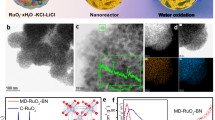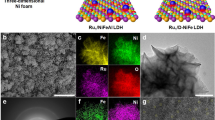Abstract
Water electrolysis powered by renewable electricity can produce clean hydrogen, but the technology is limited by the slow anodic oxygen evolution reaction (OER). The most active monometallic OER catalyst is high-valence ruthenium, but it is thermodynamically unstable. Here we leverage the strong and tunable interaction between substrate and active site found in single atom catalysts, and discover a local electronic manipulation strategy for stabilizing high-valence Ru single sites (Ru SS) on a class of Ni-based phosphate porous hollow spheres (Ru SS MNiPi PHSs where M = Fe, Co, Mn, Cu) for efficient electrolysis. Both X-ray absorption fine structure and density functional theory calculation results verify the intrinsic stability of the catalyst, and suggest that this originates from the tailored valence state, coordination number and local electronic structure of the Ru SS. We formulate general guidelines for stabilizing high-valence catalytic sites and introduce a double-volcano plot to describe the superior electrocatalytic behaviours of high-valence Ru SS. The optimum Ru SS/FeNiPi achieves a low overpotential of 204 mV and 49 mV for the OER and hydrogen evolution reaction at 10 mA cm−2, respectively. Assembling Ru SS/FeNiPi in an industrial-level electrolyser with a low Ru loading of 0.081 mg cm−2 realizes a stable industrial current density of 2,000 mA cm−2 at 1.78 V, which is the highest reported value in alkaline electrolyte to the best of our knowledge, and exceeds that of commercial Pt//RuO2 by 5.7 times.

This is a preview of subscription content, access via your institution
Access options
Subscribe to this journal
Receive 12 digital issues and online access to articles
$119.00 per year
only $9.92 per issue
Buy this article
- Purchase on Springer Link
- Instant access to full article PDF
Prices may be subject to local taxes which are calculated during checkout






Similar content being viewed by others
Data availability
The data supporting the findings of this study are available within the article and its Supplementary Information.
References
Seh, Z. W. et al. Combining theory and experiment in electrocatalysis: insights into materials design. Science 355, eaad4998 (2017).
Hwang, J. et al. Perovskites in catalysis and electrocatalysis. Science 358, 751–756 (2017).
Xia, B. Y. et al. A metal–organic framework-derived bifunctional oxygen electrocatalyst. Nat. Energy 1, 1–8 (2016).
Reier, T., Nong, H. N., Teschner, D., Schlögl, R. & Strasser, P. Electrocatalytic oxygen evolution reaction in acidic environments—reaction mechanisms and catalysts. Adv. Energy Mater. 7, 1601275 (2017).
Vojvodic, A. & Nørskov, J. K. Optimizing perovskites for the water-splitting reaction. Science 334, 1355–1356 (2011).
Grimaud, A. et al. Activating lattice oxygen redox reactions in metal oxides to catalyse oxygen evolution. Nat. Chem. 9, 457–465 (2017).
Cheng, F. et al. Rapid room-temperature synthesis of nanocrystalline spinels as oxygen reduction and evolution electrocatalysts. Nat. Chem. 3, 79–84 (2011).
Bu, L. et al. Biaxially strained PtPb/Pt core/shell nanoplate boosts oxygen reduction catalysis. Science 354, 1410–1414 (2016).
Luo, M. et al. PdMo bimetallene for oxygen reduction catalysis. Nature 574, 81–85 (2019).
Li, Y. et al. Recent advances on water‐splitting electrocatalysis mediated by noble‐metal‐based nanostructured materials. Adv. Energy Mater. 10, 1903120 (2020).
Li, M. et al. Exclusive strain effect boosts overall water splitting in PdCu/Ir core/shell nanocrystals. Angew. Chem. Int. Ed. 60, 8243–8250 (2021).
Greeley, J. & Mavrikakis, M. Alloy catalysts designed from first principles. Nat. Mater. 3, 810–815 (2004).
Mahmood, J. et al. An efficient and pH-universal ruthenium-based catalyst for the hydrogen evolution reaction. Nat. Nanotechnol. 12, 441–446 (2017).
Stoerzinger, K. A. et al. The role of Ru redox in pH-dependent oxygen evolution on rutile ruthenium dioxide surfaces. Chem 2, 668–675 (2017).
Zheng, X. et al. Theory-driven design of high-valence metal sites for water oxidation confirmed using in situ soft X-ray absorption. Nat. Chem. 10, 149 (2018).
Shan, J. et al. Charge-redistribution-enhanced nanocrystalline Ru@ IrOx electrocatalysts for oxygen evolution in acidic media. Chem 5, 445–459 (2019).
Cao, L. et al. Dynamic oxygen adsorption on single-atomic Ruthenium catalyst with high performance for acidic oxygen evolution reaction. Nat. Commun. 10, 1–9 (2019).
Muthukumaran, S. & Gopalakrishnan, R. Structural, FTIR and photoluminescence studies of Cu doped ZnO nanopowders by co-precipitation method. Opt. Mater. 34, 1946–1953 (2012).
Zhai, T. et al. Phosphate ion functionalized Co3O4 ultrathin nanosheets with greatly improved surface reactivity for high performance pseudocapacitors. Adv. Mater. 29, 1604167 (2017).
Lasia, A. in Modern Aspects of Electrochemistry 1–49 (Springer New York, 2002).
Hansen, J. N. et al. Is there anything better than Pt for HER? ACS Energy Lett. 6, 1175–1180 (2021).
Lu, S.-Y., Li, S., Jin, M., Gao, J. & Zhang, Y. Greatly boosting electrochemical hydrogen evolution reaction over Ni3S2 nanosheets rationally decorated by Ni3Sn2S2 quantum dots. Appl. Catal. B 267, 118675 (2020).
Du, H. et al. Engineering morphologies of cobalt pyrophosphates nanostructures toward greatly enhanced electrocatalytic performance of oxygen evolution reaction. Small 14, 1801068 (2018).
Rinke, M. T. & Eckert, H. The mixed network former effect in glasses: solid state NMR and XPS structural studies of the glass system (Na2O)x (BPO4)1−x. Phys. Chem. Chem. Phys. 13, 6552–6565 (2011).
Hu, Y. et al. Single Ru atoms stabilized by hybrid amorphous/crystalline FeCoNi layered double hydroxide for ultraefficient oxygen evolution. Adv. Energy Mater. 11, 2002816 (2021).
Zhou, P. et al. Atomically dispersed Co–P3 on CdS nanorods with electron‐rich feature boosts photocatalysis. Adv. Mater. 32, 1904249 (2020).
Yao, Y. et al. Engineering the electronic structure of single atom Ru sites via compressive strain boosts acidic water oxidation electrocatalysis. Nat. Catal. 2, 304–313 (2019).
Lu, B. et al. Ruthenium atomically dispersed in carbon outperforms platinum toward hydrogen evolution in alkaline media. Nat. Commun. 10, 1–11 (2019).
Sun, Y. et al. Modulating electronic structure of metal–organic frameworks by introducing atomically dispersed Ru for efficient hydrogen evolution. Nat. Commun. 12, 1–8 (2021).
Yu, H. et al. 2D graphdiyne loading ruthenium atoms for high efficiency water splitting. Nano Energy 72, 104667 (2020).
Chen, Z. et al. TM LDH meets birnessite: a 2D–2D hybrid catalyst with long‐term stability for water oxidation at industrial operating conditions. Angew. Chem. 133, 9785–9791 (2021).
Yin, J. et al. Iridium single atoms coupling with oxygen vacancies boosts oxygen evolution reaction in acid media. J. Am. Chem. Soc. 142, 18378–18386 (2020).
Li, P. et al. Boosting oxygen evolution of single-atomic ruthenium through electronic coupling with cobalt-iron layered double hydroxides. Nat. Commun. 10, 1711 (2019).
Lu, S. Y. et al. Chemically exfoliating biomass into a graphene‐like porous active carbon with rational pore structure, good conductivity, and large surface area for high‐performance supercapacitors. Adv. Energy Mater. 8, 1702545 (2018).
Clark, S. J. et al. First principles methods using CASTEP. Z. Kristallogr. 220, 567–570 (2005).
Perdew, J. P., Burke, K. & Ernzerhof, M. Generalized gradient approximation made simple. Phys. Rev. Lett. 77, 3865–3868 (1996).
Hasnip, P. J. & Pickard, C. J. Electronic energy minimisation with ultrasoft pseudopotentials. Comput. Phys. Commun. 174, 24–29 (2006).
Perdew, J. P. et al. Atoms, molecules, solids, and surfaces: applications of the generalized gradient approximation for exchange and correlation. Phys. Rev. B 46, 6671–6687 (1992).
Vanderbilt, D. Soft self-consistent pseudopotentials in a generalized eigenvalue formalism. Phys. Rev. B 41, 7892–7895 (1990).
Louie, S. G., Froyen, S. & Cohen, M. L. Nonlinear ionic pseudopotentials in spin-density-functional calculations. Phys. Rev. B 26, 1738–1742 (1982).
Grinberg, I., Ramer, N. J. & Rappe, A. M. Transferable relativistic Dirac–Slater pseudopotentials. Phys. Rev. B 62, 2311–2314 (2000).
Head, J. D. & Zerner, M. C. A Broyden–Fletcher–Goldfarb–Shanno optimization procedure for molecular geometries. Chem. Phys. Lett. 122, 264–270 (1985).
Probert, M. I. J. & Payne, M. C. Improving the convergence of defect calculations in supercells: an ab initio study of the neutral silicon vacancy. Phys. Rev. B 67, 075204 (2003).
Acknowledgements
This study was financially supported by National Science Fund for Distinguished Young Scholars (No. 52025133), National Natural Science Foundation of China (No. 52261135633), China National Petroleum Corporation-Peking University Strategic Cooperation Project of Fundamental Research, the Beijing Natural Science Foundation (No. Z220020), CNPC Innovation Found (2021DQ02-1002), New Cornerstone Science Foundation through the XPLORER PRIZE, Young Elite Scientists Sponsorship Program by CAST (2021QNRC001), the National Natural Science Foundation of China/Research Grant Council of Hong Kong Joint Research Scheme (N_PolyU502/21), Natural Science Foundation of Chongqing (CSTB2022NSCQ-MSX0557), Talent introduction of Chongqing University of Science and Technology (No. ckrc2021050, ckrc20230401), the funding for Projects of Strategic Importance of The Hong Kong Polytechnic University (Project Code: 1-ZE2V), Shenzhen Fundamental Research Scheme-General Program (JCYJ20220531090807017), the Natural Science Foundation of Guangdong Province (2023A1515012219) and Departmental General Research Fund (Project Code: ZVUL) from The Hong Kong Polytechnic University. B.H. also thanks the support from Research Centre for Carbon-Strategic Catalysis (RC-CSC), Research Institute for Smart Energy (RISE), and Research Institute for Intelligent Wearable Systems (RI-IWEAR) of The Hong Kong Polytechnic University. We thank BSRF, NSRL and SSRF for the synchrotron beam time.
Author information
Authors and Affiliations
Contributions
S.G. conceived the idea and designed this study. S.-Y.L. synthesized the samples, conducted characterization, electrochemical tests and performed MEA device. B.H. and M.S. conducted the calculation study. M.J. and H.L. performed XPS tests. H.Y., Q.Z. and L.G. performed HAADF-STEM imaging. M.L., P.Z., Y.C., K.Y., C.S., J.W., Y.W. and F.L. provided suggestions on the manuscript. S.G., S.-Y.L. and B.H. wrote the paper. All authors discussed the results and edited the paper.
Corresponding author
Ethics declarations
Competing interests
The authors declare no competing interests.
Peer review
Peer review information
Nature Synthesis thanks Bo Zhang and the other, anonymous, reviewer(s) for their contribution to the peer review of this work. Primary Handling Editor: Alexandra Groves, in collaboration with the Nature Synthesis team.
Additional information
Publisher’s note Springer Nature remains neutral with regard to jurisdictional claims in published maps and institutional affiliations.
Supplementary information
Supplementary Information
Supplementary Figs. 1–51 and Tables 1–8.
Source data
Source Data Fig. 2
Source data for Fig. 2.
Source Data Fig. 3
Source data for Fig. 3.
Source Data Fig. 4
Source data for Fig. 4.
Source Data Fig. 5
Source data for Fig. 5.
Source Data Fig. 6
Source data for Fig. 6.
Rights and permissions
Springer Nature or its licensor (e.g. a society or other partner) holds exclusive rights to this article under a publishing agreement with the author(s) or other rightsholder(s); author self-archiving of the accepted manuscript version of this article is solely governed by the terms of such publishing agreement and applicable law.
About this article
Cite this article
Lu, SY., Huang, B., Sun, M. et al. Synthetic tuning stabilizes a high-valence Ru single site for efficient electrolysis. Nat. Synth (2023). https://doi.org/10.1038/s44160-023-00444-x
Received:
Accepted:
Published:
DOI: https://doi.org/10.1038/s44160-023-00444-x
This article is cited by
-
Active site engineering accelerates water electrolysis
Nature Synthesis (2024)



